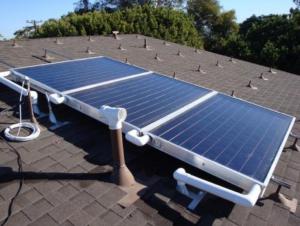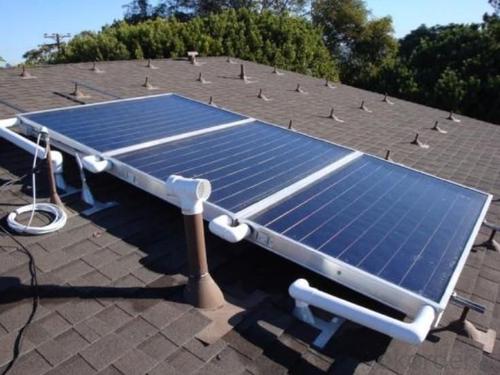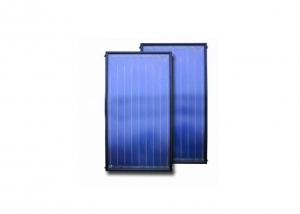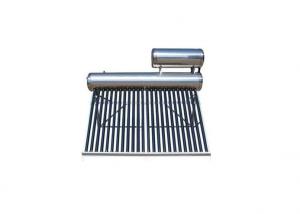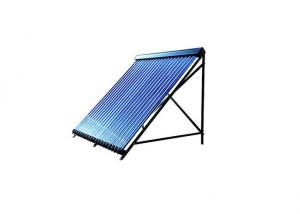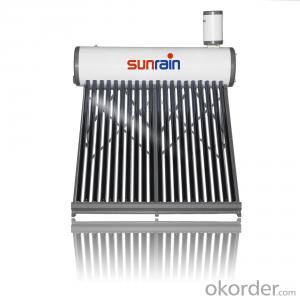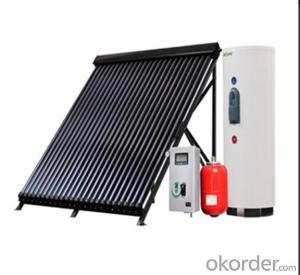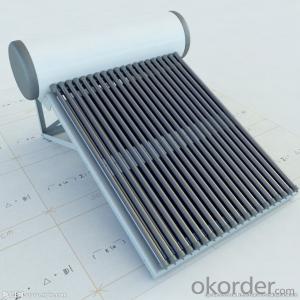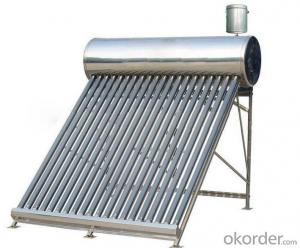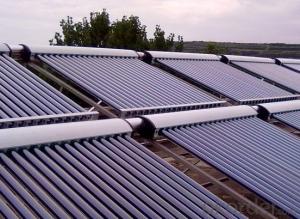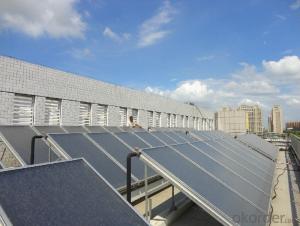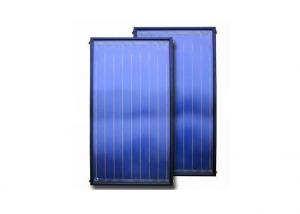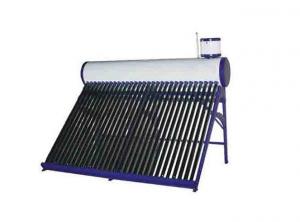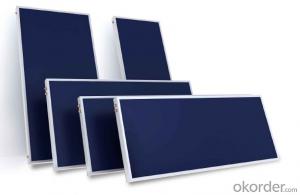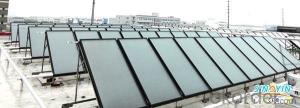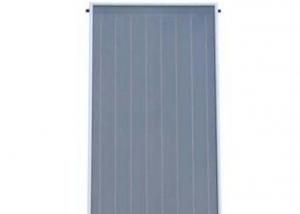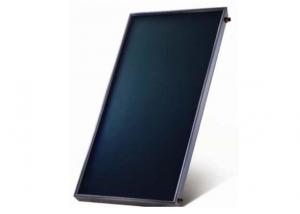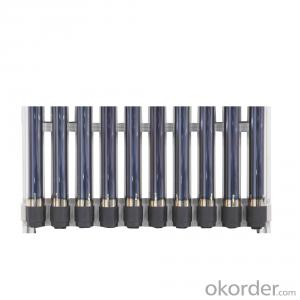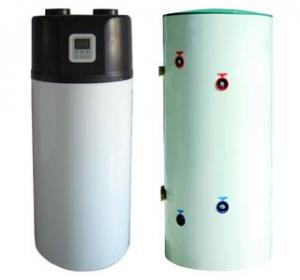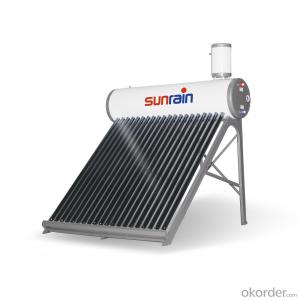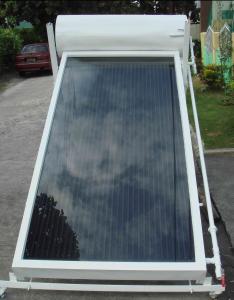Solar Flat Plate Collector for Solar Water Heater Swimming Pool
- Loading Port:
- SHENZHEN Port
- Payment Terms:
- 30%TT Before Production ,70% Before Shiooment
- Min Order Qty:
- 3000 units unit
- Supply Capability:
- 1-10000/month unit/month
OKorder Service Pledge
OKorder Financial Service
You Might Also Like
Details Of Solar Flat Plate Collector
Specifications Of Solar Flat Plate Collector
|
MODEL |
FS-PTZ Series |
|
Size of Frame(mm) |
2000×100×80 |
|
Size of Fin |
φ0.45*141mm |
|
Aperture area |
2.0 m^2 |
|
heat absorption coating |
anodic oxidation ;nickel plating |
|
Size of header pipe(mm) |
φ22×0.6 |
|
Size of branch pipe(mm) |
φ10×0.5 |
|
Frame Material |
aluminum alloy |
|
Glass Cover |
low iron ultrawhite;toughened glass |
|
Rated working pressure |
1.0MPa |
|
Carton Dimension |
2060*1040*100mm |
|
Weight(KG) |
38 |
|
Load |
110/20GP |
Advantage Of Solar Flat Plate Collector
1.Germany-Tech high efficiecy heat-absorber: Blue Film & Black Chromium;
2.High heat collecting rate of 97%, low reflection rate of 3%;
3.Absorber material: red copper, which are not easily to be corrupted with long life span 35 years;
4.Cover sheet material: toughed glasses with high transparency and less reflection rate;
5.Integrating outer shell with high intensity and well adaptability in different environment with different temperature;
6.Compact structure of outer frame and beautiful surface.
Usage/Application OfSolar Flat Plate Collector
(1) Integrated solar water heater
For independent courtyards such as villa, vacation village, rural housing and flat-roof buildings on the groundfloor.
(2) Split solar water heater
Balcony wall-mounted system is for Single-storey house, multi-storey building, small high storey,high storey and roof;
Centralized heat collecting and separate storage system is for Hotels, schools,chambers, community, entertainment sites, swimming pools
|
Packaging & Delivery Of Solar Flat Plate Collector | |
|
Packaging Detai |
Packaging Detail:Export Carton and Pallet or under customer request. |
|
Delivery Detail:10-20days | |

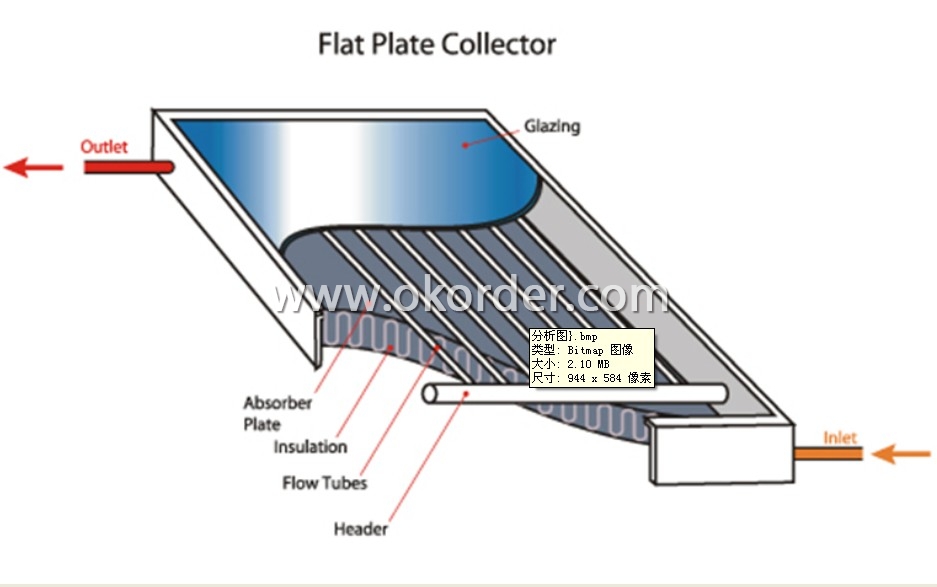
- Q: Are there any financing options available for a solar water heater installation?
- Yes, there are several financing options available for a solar water heater installation. These can include government incentives, such as tax credits or rebates, as well as loans or financing plans offered by solar companies or financial institutions. It is advisable to research and compare different options to find the most suitable financing solution for your specific needs and budget.
- Q: Can a solar water heater be used in areas with high levels of dust?
- Yes, a solar water heater can be used in areas with high levels of dust. However, it is important to regularly clean the solar panels to ensure maximum efficiency and performance. Dust buildup on the panels can reduce their ability to absorb sunlight and convert it into heat energy. Regular maintenance and cleaning will help to optimize the performance of the solar water heater even in dusty areas.
- Q: How does the altitude of a location affect the performance of a solar water heater?
- The performance of a solar water heater can be significantly influenced by the altitude of its location. As the altitude increases, the atmospheric pressure decreases, thereby impacting the boiling point of water. At higher altitudes, water boils at lower temperatures compared to sea level, which can cause a decrease in the efficiency of solar water heaters that rely on sunlight for water heating. Solar water heaters typically comprise solar collectors that absorb sunlight and convert it into heat energy. This heat energy is then transferred to the circulating water. However, at higher altitudes, the lower boiling point of water can cause premature boiling inside the collectors, resulting in the loss of thermal energy. Consequently, the overall efficiency of the system decreases, affecting its ability to effectively heat water. Furthermore, the colder temperatures often experienced at higher altitudes can further impact the performance of solar water heaters. Efficient heat transfer relies on the temperature difference between incoming cold water and heated water. If the ambient temperature is too low, the heat transfer process becomes less effective, thereby reducing the overall efficiency of the system. Additionally, the decreased atmospheric pressure at higher altitudes can affect the flow rate of water through the system. The reduced pressure results in slower water flow, hindering the heat transfer process and decreasing the system's performance. When installing a solar water heater at higher altitudes, it is crucial to consider these factors. Design modifications, such as incorporating heat exchangers or insulation materials, can help address the challenges posed by altitude and enhance the performance of solar water heaters in such locations.
- Q: Are there any regulations or permits required for installing a solar water heater?
- Yes, there are regulations and permits required for installing a solar water heater. The specific requirements may vary depending on the location and jurisdiction, but typically, building permits and compliance with local building codes are necessary. Additionally, some areas may have specific regulations regarding the type of equipment, installation, and safety measures for solar water heaters. It is advisable to consult with local authorities or a licensed professional to ensure compliance with all necessary regulations and obtain the required permits before installing a solar water heater.
- Q: How does a solar water heater affect the water temperature?
- A solar water heater increases the water temperature by utilizing the energy from sunlight to heat the water in the storage tank, resulting in a higher temperature compared to when no solar heating is used.
- Q: Can a solar water heater be used in areas with limited access to building codes and regulations?
- Yes, a solar water heater can be used in areas with limited access to building codes and regulations. Solar water heaters are relatively simple systems that do not require extensive infrastructure or complex installations. They can be easily implemented in areas with limited building codes and regulations, providing a cost-effective and sustainable solution for heating water. However, it is important to ensure proper installation and maintenance to ensure optimal performance and safety.
- Q: How does a solar water heater affect water heating time?
- A solar water heater can significantly reduce water heating time compared to traditional methods. The solar collector absorbs sunlight and heats the water, which can be much faster than relying solely on electricity or gas. Additionally, solar water heaters often use insulated storage tanks to store hot water for longer periods, ensuring a constant supply of heated water.
- Q: Are there any specific requirements for installing a solar water heater in a historic building?
- Yes, installing a solar water heater in a historic building may require specific requirements or considerations. These can vary depending on the building's historical significance, preservation regulations, and the specific solar water heater system being installed. It is advisable to consult with local authorities, historic preservation organizations, and professionals experienced in both solar water heater installations and historic building preservation to ensure compliance with any specific requirements.
- Q: How does a solar water heater affect the overall energy consumption of a household?
- The overall energy consumption of a household can be significantly reduced by utilizing a solar water heater. Unlike traditional water heaters, which rely on electricity or gas and can be energy-intensive and expensive, solar water heaters use the sun's energy to heat water with minimal additional power needed. By using solar power, households can decrease their reliance on fossil fuels and reduce greenhouse gas emissions associated with energy production. This not only helps the environment but also mitigates the negative effects of climate change. Furthermore, a solar water heater offers a more cost-effective solution in the long term. Although the initial installation cost may be higher than that of a conventional water heater, the savings over time from reduced energy consumption can be substantial. The exact amount saved will depend on factors such as local energy prices, the system's size and efficiency, and the household's hot water usage. In some regions, there are government incentives and tax credits available to encourage the adoption of solar water heaters, further alleviating the financial burden on households. This, combined with the potential long-term energy savings, makes solar water heaters a wise investment for many homeowners. In conclusion, a solar water heater can positively impact a household's energy consumption by reducing reliance on traditional energy sources, lowering utility bills, promoting environmental sustainability, and potentially providing financial incentives.
- Q: I spent ten years of solar energy, just a few days ago to find someone to deal with the scale, but still not hot, some people know what the reason
- Used for so long, the efficiency is certainly low, clean up the scale, not hot, then the problem is the insulation cylinder, a long time, poor thermal insulation, the temperature can not be retained. Suggest you change a new set of,
1. Manufacturer Overview
| Location | Guangdong,China |
| Year Established | 1990 |
| Annual Output Value | Below US$1 Million |
| Main Markets | WORLDWIDE |
| Company Certifications |
2. Manufacturer Certificates
| a) Certification Name | |
| Range | |
| Reference | |
| Validity Period |
3. Manufacturer Capability
| a) Trade Capacity | |
| Nearest Port | GUANGDONG,SHENZHEN |
| Export Percentage | 61% - 70% |
| No.of Employees in Trade Department | more than 200 |
| Language Spoken: | English, Chinese |
| b) Factory Information | |
| Factory Size: | 500 square kilometre |
| No. of Production Lines | 2 |
| Contract Manufacturing | |
| Product Price Range | |
Send your message to us
Solar Flat Plate Collector for Solar Water Heater Swimming Pool
- Loading Port:
- SHENZHEN Port
- Payment Terms:
- 30%TT Before Production ,70% Before Shiooment
- Min Order Qty:
- 3000 units unit
- Supply Capability:
- 1-10000/month unit/month
OKorder Service Pledge
OKorder Financial Service
Similar products
Hot products
Hot Searches
Related keywords
